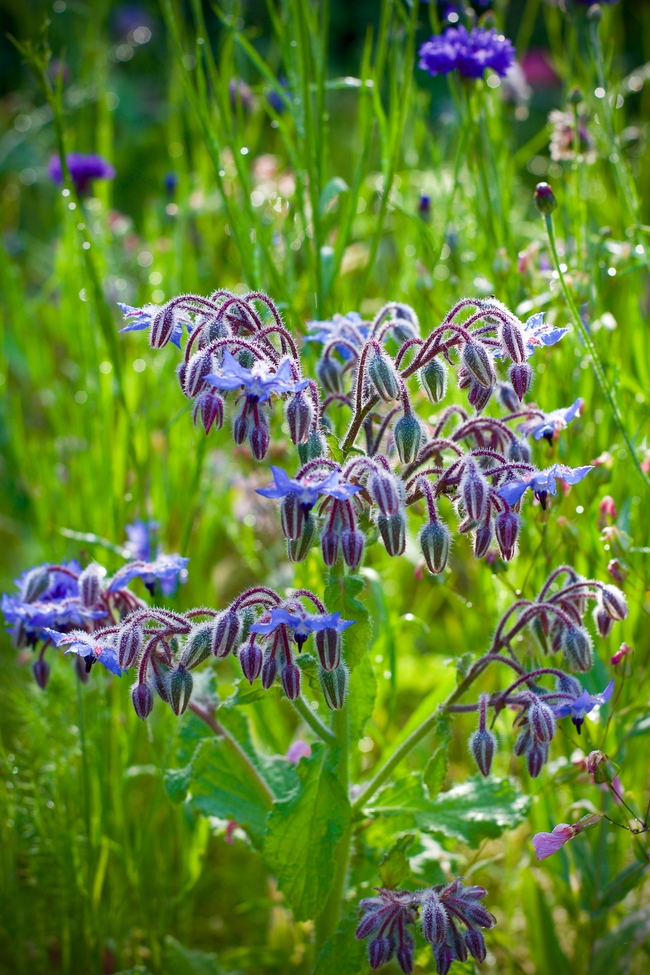Well, it is that time again. The holidays are over so I can spend dreamy nights curled up on the couch with the seed catalogues and sunny winter days digging in the garden beds. Ah, a gardener's heart filled with hope and joy for the coming season!
Thinking back on my veggie gardens, I have always planted borage. Somewhere along the way, someone made sure I knew how important it is as a garden addition. It attracts pollinators, is a beneficial companion plant, has nutritious edible leaves and flowers, is virtually pest free, and, as a bonus, it is a prolific self-seeder.
A historic medicinal herb, Borage (Borago officinalis), is a Mediterranean annual also known as starflower, bee bush, bee bread, and bugloss. It's not only a favorite plant of honey bees, but also attracts bumble bees and small, native bees. It has served many purposes from the time of ancient Rome to the present. Pliny the Elder believed it to be an anti-depressant, and that it gave courage and comfort to the heart. Francis Bacon thought that borage had "an excellent spirit to repress the fuliginous vapour of dusky melancholie.” One old wives' tale states that if a woman slipped a bit of borage into a promising man's drink, it would give him the courage to propose.
John Gerard's Herball (Published in 1597) mentions an old verse concerning the plant: "Ego Borago, Gaudia semper ago (I, Borage, bring always joys)". He states that "Those of our time do use the flowers in salads to exhilerate and make the mind glad. There be also many things made of these used everywhere for the comfort of the heart, for the driving away of sorrow and increasing the joy of the mind. The leaves and flowers of Borage put into wine make men and women glad and merry and drive away all sadness, dullness and melancholy, as Syrup made of the flowers of Borage comfort the heart, purge melancholy and quiet the frantic and lunatic person. The leaves eaten raw engender good blood, especially in those that have been lately sick.”
At one time borage was grown by beekeepers to boost honey production. It can be grown as an ornamental plant, but is also edible. You could say that borage is a sort of super plant.
In the garden, the claimed uses of borage include repelling pests such as hornworms, attracting pollinators, and aiding any plants it is interplanted with by increasing resistance to pests and disease. It is also helpful to, and compatible with, most plants — notably tomatoes, strawberries, legumes, spinach, brassicas, and squash. Some strawberry farmers set a few plants in their beds to enhance flavor and yield. Tomatoes planted near borage seem to improve in growth and disease resistance. Borage adds trace minerals to the soil it is planted in, and is good for composting and mulching.
It is an annual, but readily self-seeds and thrives in full sun. It is so proficient in self-seeding, in fact, that once a borage plant has established itself in your garden, you will likely never have to reseed again! The bloom period is different for various climates and growing zones. In my garden, borage will bloom from mid-spring to early fall. Borage will bloom for many weeks if the older flowers are trimmed off, and you can often push tattered plants to make a comeback by pruning them back halfway in midsummer. Healthy borage plants shed numerous black seeds, so expect to see volunteers for two years after growing borage. Self-sown borage seedlings are easy to dig and move, or you can pull and compost the ones you don't want.
Now, you may be thinking, “This is amazing! How in the world do I grow this miracle plant for myself?” It's quite simple actually. Seeds germinate easily and are best sown in full or partial sun under ½ inch (1 cm) of soil. Borage is not fussy and grows happily in poor soil. It's easy to sprinkle a patch with seeds and then cover it with a few handfuls of soil or compost. The plants can easily grow to be 3 feet (91 cm) tall and 2 feet (61 cm) wide, so give them room to grow, and let them shade your partial sun plants. Water well until the seeds germinate and the plants are established, then water only when dry. Feed monthly with a balanced organic fertilizer at half the recommended rate. Treat this easy-to-keep herb well and it will reward you with scores of beautiful flowers, lush foliage, and fertile soils.
If the Borage begins to take over your garden just thin out by hand pulling the plants out. The shallow roots will dislodge easily. Remember that the stalks are prickly, so you may need to wear garden gloves.
